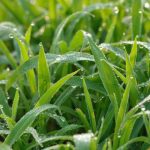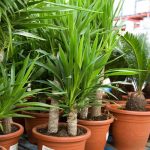Its name means small in size, but the dwarf palmetto packs a big drought-tolerant punch! And it’s a unique evergreen addition to your garden.
Is your garden in need of an evergreen plant that can handle variable soil moisture and lighting conditions?
Meet the dwarf palmetto, also known as Sabal minor. You may have seen this small palm heading east on I-10 as you leave San Antonio, with specimen occurrence increasing as you approach the Louisiana border.
This palm has a very large range and can be found all the way to the east coast. As a matter of fact, Central Texas is on the very edge of its western range. In our area it can be seen growing in colonies along the Guadalupe River in Kendall County and even near Helotes. Dwarf palmetto belongs to the Arecaceae family which includes other fan palms. Members of this plant family can be found all over the world in tropical and sub-tropical environments.

Historically, palms have been used to make wharf pilings, thatched roofs, rattan furniture, woven mats and baskets. There are also many species that produce foods, such as the date palm and the coconut palm.
While the Sabal minor is typically found near moisture, it can actually be quite drought-tolerant once established. But one of my favorite things about this plant is its size: its height maxes out at about 5 feet (unlike other palms that can reach upwards of 50 feet), which means that it can accommodate smaller spaces.
Another uncommon characteristic of this plant is its ability to thrive in areas with poor drainage. It doesn’t mind shade and will maintain its foliage throughout the winter months. But I don’t recommend planting it in thin soil in full sun because it just wouldn’t do well. Think dappled sun or shade under the protection of some large trees. It can grow in full sun too, but may require deeper soil and may need supplemental water, especially during the hottest months of the year.
Plant with other shade-tolerant plants like velvet-leaf mallow, Turk’s cap, broadleaf wood oats, Heller’s marbleseed, three-flower melic grass, southwest bristlegrass, tropical sage, pigeonberry, Missouri violet, white mistflower, river fern, red or yellow columbine, aromatic sumac, evergreen sumac, Barbados cherry, coralberry, Lindheimer’s silktassel, wax myrtle, agarita, etc.
This plant would be perfect at the base of a raingarden (where it can be periodically inundated by our most precious resource). Group with other plants that are capable of surviving similar conditions such as fall obedient plant, big bluestem, eastern gama grass, cardinal flower, goldenrod, bushy bluestem, Lindheimer’s muhly, broadleaf wood oats, snake herb or frogfruit.
Whatever your plan is for this palm, it will be a unique and delightful evergreen addition to your garden. It may even be the perfect solution to that pesky wet spot in your garden that never drains!




